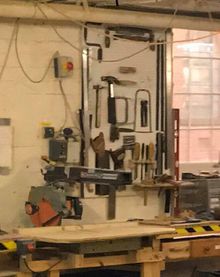Hand Saws: Difference between revisions
Jump to navigation
Jump to search
Split Wood tools |
mNo edit summary |
||
| Line 8: | Line 8: | ||
|team=Woodworking | |team=Woodworking | ||
|induction=No | |induction=No | ||
|defunct= | |defunct= | ||
|defunctdate= | |defunctdate= | ||
}} | }} | ||
Revision as of 00:42, 23 February 2019
| Hand Saws | |
|---|---|
 | |
| Manufacturer | Various |
| Model | Various |
| Location | Workshop |
| Team | Woodworking |
| Induction Required | No |
| Tools: all pages • list • Power Tools • Broken tools {{}} | |
There are various hand saws around the space.
Woodworking area
- Mitre saw (in jig under work bench) - for cutting specific angles such as 45° for making picture frames.
- Tennon saw - for accurate wood working: e.g. joints.
- Cross-cut saw - cutting across grain in larger pieces of softer woods.
- Rip saw - cutting along the grain of in larger soft wood pieces.
- Hack saw - cuts metal, plastic & wood.
- Junior hack saw - most useful for smaller metal work.
- Coping saw - cutting intricate shapes with right curves.
- Japanese pull saws - fine wood working.
Links & more info
A good introduction to hand saws - which ones to use for what jobs, technique and so on, from Boing Boing